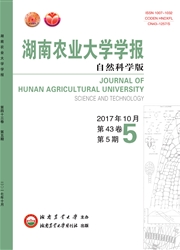

 中文摘要:
中文摘要:
在前期克隆芍药AP1基因(登录号为KC354376)的基础上,运用CHIPS、CUSP和Codon W在线程序,分析芍药AP1基因的密码子偏好性,并与其他物种的AP1基因以及模式生物的基因组进行比较。结果表明,芍药AP1基因大部分偏好使用以A/T结尾的密码子,29种偏好密码子(RSCU值〉1)中,偏好性较强的有CCA、AGG、TCA、GTT(RSCU值≥2);通过比较12种植物的AP1基因密码子偏好性,发现AP1基因在芒果和梨中的表达水平相对较高,而在芍药和牡丹等植物中的表达水平一般,并且大多偏好以A/T结尾的密码子,这可能与该基因的特殊功能有关;聚类分析结果表明,芍药科中芍药与牡丹聚为一类,梨和碧桃聚为一类;在密码子的使用频率上,芍药AP1基因与酵母基因组的差异小于与大肠杆菌和拟南芥基因组的差异,酵母真核表达更适合作为芍药AP1基因的外源表达系统。本研究结果可为芍药AP1基因在遗传改良中选择合适的受体植物、选择较佳的外源表达系统以及提高该基因的表达水平提供参考依据。
 英文摘要:
英文摘要:
AP1 (APETALA 1) gene might be associated with regulation of floral organ development in Paeonia lactiflora. To understand codon bias features ofAP1 gene and for further selecting appropriate expression systems, AP1 gene was analyzed via online programs of Codon W, CHIPS and CUSP on the basis of previous molecular cloning of P lactiflora (the accession number: KC354376), it was also compared among AP1 genes and other 12 plant species and genomes in model organisms. The results showed that most of the AP1 genes had bias toward the synonymous codons with A and T at the third codon position. There were 29 biased codons with the RSCU value larger than 1, and among of them, the stronger biased codons were CCA, AGC~ TCA and GTT with the RSCU value larger than 2. By comparison the bias of AP1 genes with that of 12 plant species, it also found that gene expression levels in Mangifera indica and Pyrus pyrifolia were higher, while they showed common in Paeonia lactiflora and Paeonia suffruticosa wtih the bias toward the synonymous codons with A and T at the third codon position, which was related to specific functions of the gene. The results from the clustering analysis showed that Paeonia lactiflora and Paeonia suffruticosa belonged to Paeoniaceae, while Pyrus pyrifolia and Prunus persica belonged to another. The differences in codon usage frequency between AP1 gene and yeast genome were less than those of other two kinds of model organisms' genomes. Therefore, the eukaryotic yeast expression systems might be more suitable for the expression of AP1 gene. This study could provide certain theoretical base for selecting the appropriate receptor plant and expression systems in genetic improvement, as well as improving the expression level ofAP1 gene.
 同期刊论文项目
同期刊论文项目
 同项目期刊论文
同项目期刊论文
 期刊信息
期刊信息
